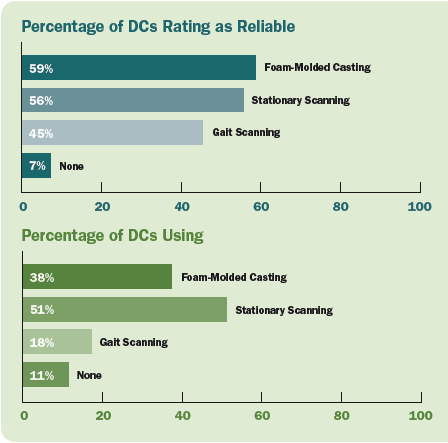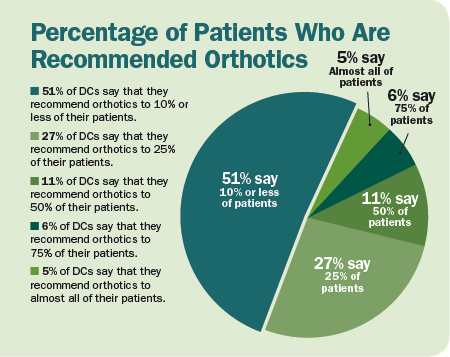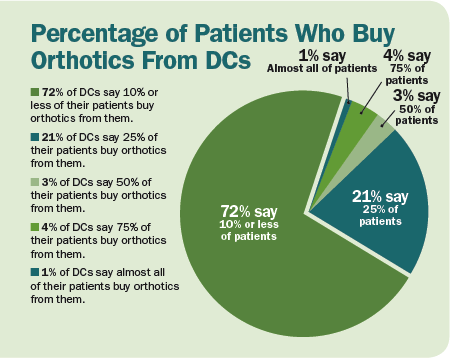New York's highest court of appeals has held that no-fault insurers cannot deny no-fault benefits where they unilaterally determine that a provider has committed misconduct based upon alleged fraudulent conduct. The Court held that this authority belongs solely to state regulators, specifically New York's Board of Regents, which oversees professional licensing and discipline. This follows a similar recent ruling in Florida reported in this publication.
Confidence and Conflict: Orthotics in Chiropractic Practice
Unlike many other products and services offered by doctors of chiropractic, a relatively small number of companies provide orthotics to the chiropractic profession in the U.S. There are actually more orthotics companies serving Canadian chiropractors than there are serving American chiropractors.
Eighty-two percent of doctors offer orthotics to their patients. While this is a substantial number, it still leaves almost one-fifth of the profession that does not offer orthotics. By comparison, topical analgesics are used by 91 percent of the profession and 96 percent are offering nutritional supplements.
Unlike nutritional supplements, the vast majority of doctors only offer one brand of orthotics to their patients. This again is a considerable contrast, as almost half of chiropractors offer four or more nutritional supplement brands to their patients.
Casting vs. Scanning
A question of reliability exists in the minds of chiropractors when it comes to measuring a patient's feet for orthotics, to which there is no clear-cut winner. The conflict centers around a comparison between foam-molded casting, stationary scanning and gait scanning. Here, the profession is almost evenly divided, with less than 60 percent of the profession believing that any one of the three provides "reliable information."

Foam-molded casting was rated reliable by 59 percent of doctors, with stationary scanning believed reliable by 56 percent. Gait scanning comes in under half, with 45 percent of chiropractors rating it as reliable.
When the above percentages are compared to which form(s) of measuring the doctor is currently using, they paint an interesting picture. While foam-molded casting is believed reliable by 59 percent of the doctors, only 38 percent use it. Stationary scanning, on the other hand, is believed reliable by 56 percent of the profession and used by a close majority (51 percent), the highest percentage of the three. Gait scanning, while considered reliable by 45 percent of chiropractors, is only used by 18 percent.

[pb]Understanding the Science and Benefits
The application of orthotics requires that the doctor of chiropractic understand both the science behind them and the benefits to the patient. The vast majority of doctors reported that they have a good understanding of each of these issues. Ninety-six percent of chiropractors "understand the benefits" of orthotics for their patients either very well (66 percent) or somewhat well (30 percent). Ninety-four percent report that they "understand the science behind orthotics" either very well (53 percent) or somewhat well (41 percent).
Recommendations and Purchasing
Only a small number of doctors (5 percent) recommend orthotics to "almost all" of their patients. Almost one-fourth (22 percent) of chiropractors recommend orthotics to at least half of their patients. Just over half (51 percent) recommending orthotics to 10 percent or fewer of their patients. Based upon these recommendations, only 1 percent of doctors report that "almost all" of their patients buy orthotics from them. Only 8 percent report that at least half of their patients purchase from them, with almost three-quarters (72 percent) of chiropractors reporting that less than 10 percent of their patients purchase orthotics.

Confidence in Recommending
Doctors are surprisingly confident that they are recommending orthotics appropriately. When asked "How confident are you that you are recommending orthotics/pelvic stabilizers to the patients who really need them?" more than two-thirds (69 percent) reported that they are very confident. Another 23 percent reported that they are somewhat confident. Less than one in 10 reported that they are not very confident (7 percent) or not confident at all (1 percent) that they are recommending orthotics to patients who really need them.
Conclusion
More than 80 percent of chiropractors recommend orthotics some of the time to their patients. This makes orthotics one of the important services offered by the chiropractic profession in the United States. Most doctors of chiropractic believe they understand the science behind the application of orthotics and the benefits to their patients to effectively provide them. This contributes to the high level of confidence doctors hold in their ability to assess and recommend orthotics appropriately.
However, there is still a bit of contention when it comes to the method of measuring the feet properly. Doctors are divided almost evenly between the three most commonly used methods of measurement as to which they believe is reliable. None of the three is seen as reliable by two-thirds of the profession. While it may come down to personal preference or experience, the issue of measurement is one in which doctors may want to gain additional information to better understand the advantages of each measurement approach.
Reference
- Chiropractic Distributor Survey. MPA Media, completed September 24, 2009.


